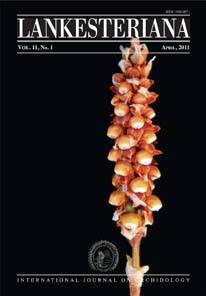Anatomía foliar de ocho especies de orquídeas epífitas
DOI:
https://doi.org/10.15517/lank.v11i1.18314Keywords:
Anatomía foliar, Orchidaceae, Epifitismo, Adaptación, Leaf anatomy, Epiphytism, Adaptation.Abstract
Leafs of representative epiphytic orchids were examined for anatomical detail. Four species representing the different epiphyte categories were selected for the study: Oncidium abortivum Rchb.f. (humus epiphyte), Epidendrum excisum Lindl. (branch epiphyte), Rodriguezia lehmannii Rchb.f., and Hirtzia escobarii Dodson(twig epiphytes). Additionally, four orchid species capable of developing as terrestrial plants and as epiphytes were also examined: Elleanthus oliganthus (Poepp. & Endl.) Rchb.f., Elleanthus purpureus (Rchb.f.) Rchb.f. Pleurothallis cordifolia Rchb.f. & H.Wagener, and Stelis sp. Various xerophytic characters, that could be considered leaf adaptations to water shortage in the epiphytic habit, were common for most species: greater development of adaxial epidermal cells, stomata with protected pores, occurrence of hypodermis, presence of fiber bundles, different type of idioblasts, and sclerenchyma present adjacent to the xylem and phloem. Twig epiphytes, restricted to the outermost axes of their hosts, exhibit several of these modifications.
Downloads
Downloads
Published
How to Cite
Issue
Section
License
According to the Open Access policy promoted by the University of Costa Rica, all the papers published by Lankesteriana are licensed under the Creative Commons copyright and can be downloaded free of charge. The journal holds copyright and publishing rights under the CC BY-NC-ND 3.0 CR license.
Before the publication of the materials submitted by the author(s) in LANKESTERIANA, the author(s) hereby assign all rights in the article to the Lankester Botanical Garden.





